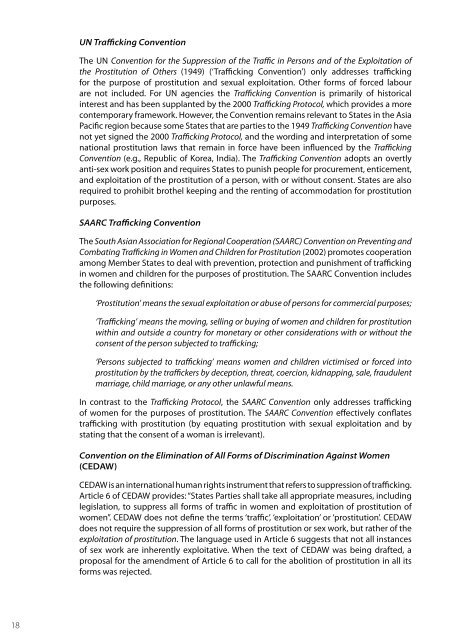SEX WORK AND THE LAW - HIV/AIDS Data Hub
SEX WORK AND THE LAW - HIV/AIDS Data Hub
SEX WORK AND THE LAW - HIV/AIDS Data Hub
Create successful ePaper yourself
Turn your PDF publications into a flip-book with our unique Google optimized e-Paper software.
UN Trafficking Convention<br />
The UN Convention for the Suppression of the Traffic in Persons and of the Exploitation of<br />
the Prostitution of Others (1949) (‘Trafficking Convention’) only addresses trafficking<br />
for the purpose of prostitution and sexual exploitation. Other forms of forced labour<br />
are not included. For UN agencies the Trafficking Convention is primarily of historical<br />
interest and has been supplanted by the 2000 Trafficking Protocol, which provides a more<br />
contemporary framework. However, the Convention remains relevant to States in the Asia<br />
Pacific region because some States that are parties to the 1949 Trafficking Convention have<br />
not yet signed the 2000 Trafficking Protocol, and the wording and interpretation of some<br />
national prostitution laws that remain in force have been influenced by the Trafficking<br />
Convention (e.g., Republic of Korea, India). The Trafficking Convention adopts an overtly<br />
anti-sex work position and requires States to punish people for procurement, enticement,<br />
and exploitation of the prostitution of a person, with or without consent. States are also<br />
required to prohibit brothel keeping and the renting of accommodation for prostitution<br />
purposes.<br />
SAARC Trafficking Convention<br />
The South Asian Association for Regional Cooperation (SAARC) Convention on Preventing and<br />
Combating Trafficking in Women and Children for Prostitution (2002) promotes cooperation<br />
among Member States to deal with prevention, protection and punishment of trafficking<br />
in women and children for the purposes of prostitution. The SAARC Convention includes<br />
the following definitions:<br />
‘Prostitution’ means the sexual exploitation or abuse of persons for commercial purposes;<br />
‘Trafficking’ means the moving, selling or buying of women and children for prostitution<br />
within and outside a country for monetary or other considerations with or without the<br />
consent of the person subjected to trafficking;<br />
‘Persons subjected to trafficking’ means women and children victimised or forced into<br />
prostitution by the traffickers by deception, threat, coercion, kidnapping, sale, fraudulent<br />
marriage, child marriage, or any other unlawful means.<br />
In contrast to the Trafficking Protocol, the SAARC Convention only addresses trafficking<br />
of women for the purposes of prostitution. The SAARC Convention effectively conflates<br />
trafficking with prostitution (by equating prostitution with sexual exploitation and by<br />
stating that the consent of a woman is irrelevant).<br />
Convention on the Elimination of All Forms of Discrimination Against Women<br />
(CEDAW)<br />
CEDAW is an international human rights instrument that refers to suppression of trafficking.<br />
Article 6 of CEDAW provides: “States Parties shall take all appropriate measures, including<br />
legislation, to suppress all forms of traffic in women and exploitation of prostitution of<br />
women”. CEDAW does not define the terms ‘traffic’, ‘exploitation’ or ‘prostitution’. CEDAW<br />
does not require the suppression of all forms of prostitution or sex work, but rather of the<br />
exploitation of prostitution. The language used in Article 6 suggests that not all instances<br />
of sex work are inherently exploitative. When the text of CEDAW was being drafted, a<br />
proposal for the amendment of Article 6 to call for the abolition of prostitution in all its<br />
forms was rejected.<br />
18
















